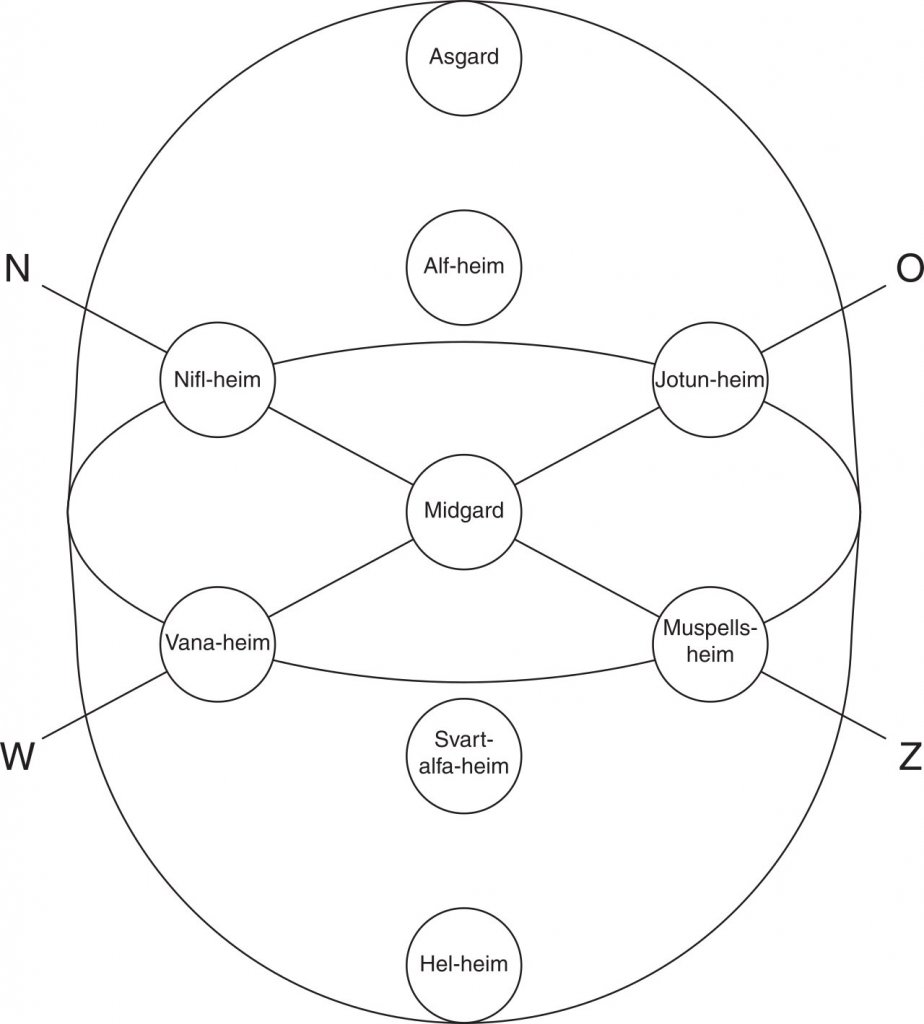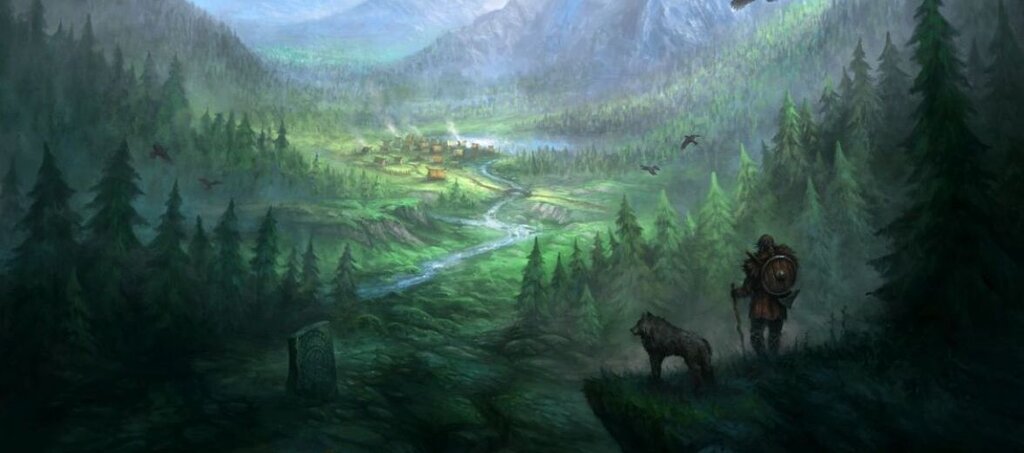As its name suggests, Midgard occupies the center position in the tree of Norse cosmology. It is the land of humans in the middle of a giant sea. Jormungand (Old Norse: Jormungandr or the Midgard Serpent) lies in this sea and encircles the entire world.
Midgard Synonyms
Midgard (Old Norse Miðgarðr or Midgardr) is also known as Middleworld, Middle Earth, and Manna-Heim (or “Home of Man”).
In Old English, people called it Middangeard, while the Old Saxons knew it as Middilgard. Its name was Mittilagart in Old High German and Midjun-gards in Gothic.
What Does Midgard Mean in English?
The literal translation of Midgard, an Anglicized form of the Old Norse word Miðgarðr, is “middle-fence” or “middle enclosure.”
Popular opinion claims that Norse mythology cites opposites of geographical regions and psychological states as Innangard (Old Norse: Innangarðr) and Utangard (Old Norse: Útgarðr). Innangard means “within a fence,” and Utangard means “outside a fence.” The idea is that somewhere Innangard is controlled, peaceful and serene, while something Utangard is hostile, wild, and anarchic.
Two of the nine realms are Innangard: Midgard and Asgard. Because these lands contain “gard” in their name, we can suppose they are inside a fence or boundary of some description and therefore possess an element of control.
The other seven realms end in “heim” (or home) and would be “Utangard,” indicating a wilder nature in terms of their inhabitants and environment.
Where is Midgard in Norse Mythology?
There is some confusion about the positions of the various realms within Norse mythology. The placement of Vanaheim, for example, can vary depending on which map you use. However, the most common positions of the nine worlds are as follows:
Asgard always lies in the highest and central section of the world tree or Yggdrasil. It is usually flanked by Vanaheim and Alfheim. Directly below Asgard lies Midgard. The tree trunk usually connects the two places, so the Bifrost or rainbow bridge can join them.
Further down, we have Jotunheim (land of the ice giants), Muspelheim (land of fire giants and the god Surtr), Niflheim (land of snow and ice), and Hel (or Helheim, pretty self-explanatory – the land of the dead).
Mention of the final realm, Nidavellir(land of dwarves), has been kept separate as it requires a little explanation. Nidavellir is often called Svartalfheim (home of the Black Elves or Svartálfar). However, some maps separate Nidavellir from Svartalfheim and exclude Niflheim completely.

The Connection Between Asgard and Midgard: The Bifrost
The leader of Asgard, Odin, was directly responsible for creating Midgard. After its construction, he established a direct link between Asgard and Midgard using the rainbow bridge or Bifrost.
How was Midgard Created?
The sons of Bor Burison, Odin, Vili, and Vé created Midgard using the remains of the frost giant Ymir. Ymir was the oldest being in the whole of Norse myth and lived in the primordial void called Ginnungagap.
The reasons for them deciding to kill him are not clear.
Some claim they merely wanted a giant being to provide enough material to create a world. Others believe that Ymir’s antics, such as giving birth from his armpits and apparently producing a six-headed being from between his legs, annoyed the gods enough to want him killed.
These three brothers slaying him is ironic, to say the least, as their grandfather, Búri owed his existence to a cow that Ymir suckled on. The cow called Auðumbla liked to lick salty rime stone encased in ice, and this gradually melted, uncovering Búri, who came to life!
Odin killed the giant with his spear; with so much blood pouring from the wound, it drowned all the jötnar except for Bergelmir and his wife. They escaped in a hollowed-out log and were responsible for the subsequent repopulation of the giants in Jotunheim.
Ymir’s flesh and blood (and, in some accounts, worms) also created the race of dwarves.
The Birth of Midgard
The brothers took the giant’s body (Yimir’s) to the center of the universe and used his body parts to create Midgard. They used his flesh to develop the land; his blood became the oceans. His bones made the mountains, his teeth the cliffs, and his hair the trees! His brains scattered across the sky to form clouds.
To create the sky, the trio had commanded four dwarves to hold Ymir’s skill above the new world. The dwarves’ names provided the four compass points: Nordri, Sudri, Austri, and Vestri. Scattered sparks caught in the skull gave the sun, moon, and stars.
To protect the new world they had made, they used Ymir’s eyebrows to fence off the new land from the rest of the universe, only allowing access to Asgard via the Bifrost.
Who is the Ruler of Midgard?
Midgard never proclaimed a king or queen. The closest they had to a ruler was the god of thunder, Thor.
Thor was the designated protector of the realm and cared for humankind as much as he did his own, seeing off threats from enemies such as the jötunn.
Is Midgard destroyed in Ragnarök?
The Poetic and Prose Eddas both mention the destruction of Midgard during Ragnorök or the end of the world.
The serpent Jörmungandr would rise from the ocean surrounding the realm, poisoning the land with its venom and causing tsunamis that tear the world apart.
Is Midgard also Real Place?
No settlement or region on Earth is or ever has been called Midgard.
A Midgard Base Camp in modern-day Hvolsvöllur, Iceland, serves as the headquarters for a Nordic mythology excursion company visiting nearby sites named after Norse gods. The jeeps that take you to these locations are called Odin and Thor!
The Midgard Viking Centre in Borre, Norway, is a museum for all things connected to the Viking age!
What are humans called in Norse mythology?
The only reference to named humans in Norse mythology is from when Odin and his brothers had finished making Midgard. They then used an ash tree to create, Ask, the first man, and an elm to make, Embla, the first woman. The brothers then imbued the couple with our familiar human traits.
In this account from Benjamin Thorpe’s 1866 translation of Vǫluspá, the brothers of Odin are Hoenir and Lodur.
Spirit they possessed not, sense they had not,
Blood nor motive powers, nor goodly color.
Spirit gave Odin, sense gave Hœnir,
blood gave Lodur, and goodly color.

